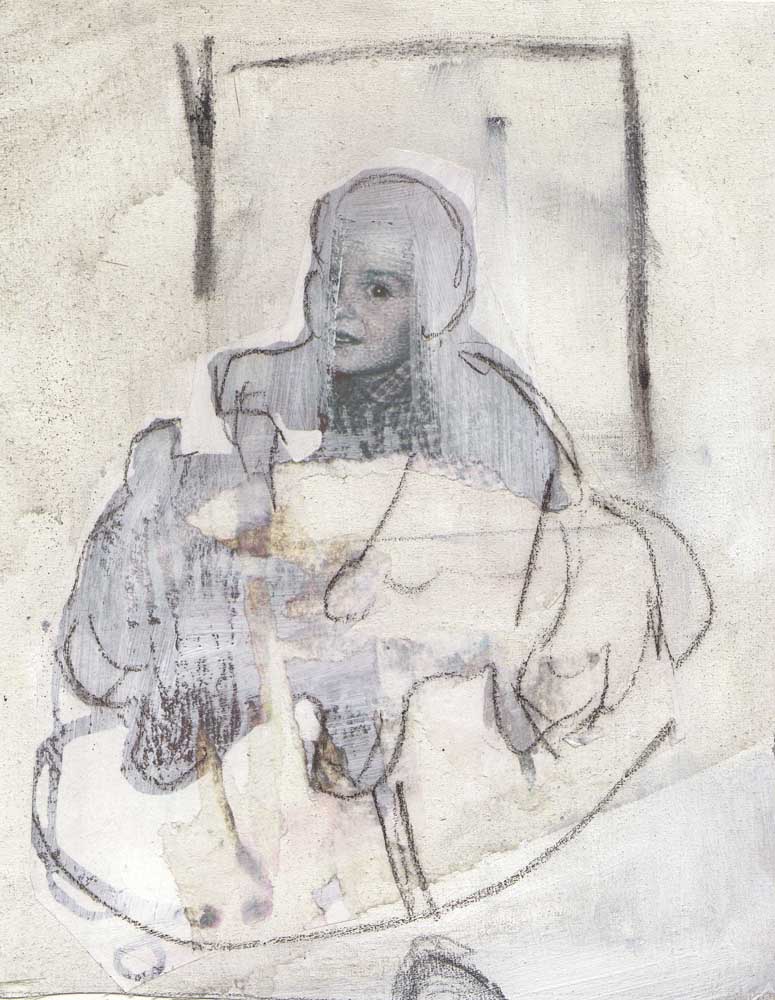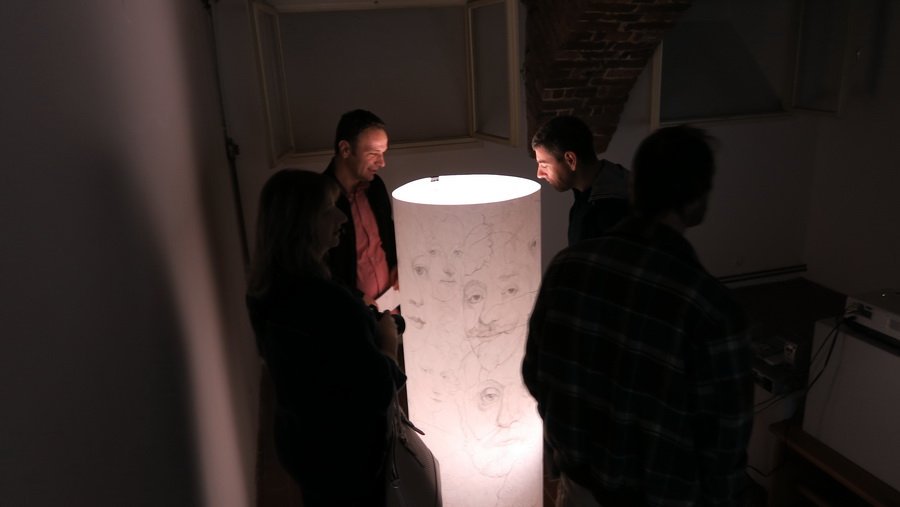
Boy’s self-portrait I, 2017, combined technique, 21 x 16 cm 
Boy’s self-portrait II, 2017, combined technique, 21 x 16 cm 
Boy’s self-portrait, 2017, combined technique, 21 x 16 cm 
Herceg Koloman, 2017, digital print, 237 x 110 cm 
Temptation 1, 2015, combined technique, 150 x 98 cm 
Temptation, 2015, combined technique, 150 x 98 cm 
Portrait with a triangle, 2013, acrylic, pencil and oil paint on paper, 100 x 100 cm 
Based on Diego Velazquez’ self-portrait, 2015 oil on canvas, 50 x 70 cm 
Observing the observer, 2018, light installation, pencil on paper, 150 x 70 cm 
Observing the observer, a detail 
Voyage I, 2016, combined technique, 26 x 17,5 cm 
Voyage II, 2016, combined technique, 26 x 17,5 cm 
Voyage , 2016, combined technique, 26 x 17,5 cm 
Sacra conversatio, 2016, a photograph of a video, 19 min i 47s 
Stjepan II, 2017, digital print, 237 x 110 cm 
In the atelier, 2016, a photograph, 175 x 124 cm 
On the move I, 2017, combined technique, 27 x 21 cm 
On the move II, 2017, combined technique, 27 x 21 cm 
On the move, 2017, combined technique, 27 x 21 cm
In a time encumbered by the accumulation of material goods that often secure a position of power and dominance, an individual suppresses their spiritual needs ignoring the fact that these are crucial for the development of their personality. Every human is primarily a spiritual being, and their self-being is the central component of the person – the core of every man which never changes. In order to detach ourselves from our material environment and reach the spiritual dimension, we need peace and quiet in which we find solutions and get our inspiration. People often used to find their peace in churches in the past. Sacral architecture masterpieces provoked veneration, while their monumental interior filled with the strong presence of the transcendental allowed for the experience of a broader picture of life that transcends this earthly material world.
Matko Antolčić seeks for the beauty of Christian spirituality inspired by the works of old masters in the field of religious themes. Inspired by the alienation of the contemporary world in which the key link between fine arts and Christian doctrine has gradually been lost, the author seeks to restore the spirit of a time when old masters approached the interpretation of sublime religious themes with great responsibility and awe. Antolčić does not copy a certain style or historical period, he is rather guided by the admiration achieved when the spiritual in art and the spiritual in a man unite under the auspices of the church. Being with oneself in front of a work of art in a monumental architectural building made it possible to reach a state of consciousness in which a man surrenders to the development of his own spirituality through religious devotion to God.
Inspiration by the old masters primarily implies a blend of art and spirituality, admiration and respect that is developed between the artist, the interpreted motif and the observer. Matko Antolčić successfully returns to original values in a modern way with his own expression through an authentic handwriting and the realization of ideas in various media.
The works Sacra conversazione and Sacred Identity are inspired by the works of the great masters of the Italian High Renaissance and the Spanish Baroque. Antolčić interprets the theme of sacred conversation and the depiction of famous saints, combining the human and the sacred, the ordinary and the sublime, the historical and the contemporary. Fr. Bartolomeo’s painting The Mystical Engagement of St. Catherine of Siena is the starting point for the interpretation of a classic theme in the modern medium – a video. Although the scenery, location and scene are precisely defined, the artist gives the participants complete freedom of movement and interaction. The classic theme is set in the present time, where the socio-sociological experiment, with minimal intervention of the author, allows following the spontaneous development of interaction between the protagonists. With time, everyone gradually focuses on the child, who becomes the uniting factor of this work of art. Although we do not hear specific conversations, the tone and intonation together with the gestures of the characters define the character of the scene, while the strong echo indicates that it is the monumental space that contributes to the sacral atmosphere.
In the work Saints’ Identity, the drawing of larger dimensions consists of a whole of six saints interpreted on the basis of photographs of models in the roles of certain saintly characters. Unlike Francisco de Zurbarán, who placed his figures of saints in obscure spaces, building a composition with strong contrasts between dark and illuminated parts of the painting, Matko Antolčić deviates from the model and shapes the saints with a linear ink drawing. He emphasizes the attributes, that is, the symbols of an individual saint, and he performs it with a lot of details. A drawing lacking any background and space draws attention to the character of the individual interpreted saint. Taking ordinary people who correspond in character to persons who have been canonized for their way of life devoted to Christ, the author combines the human, the sublime and the divine in his work.
Besides connecting the past and the present, holiness and humanity through the medium of art, Matko Antolčić creates works in which he allows the observer to enter his personal world. The photograph In the Atelier followed the example of famous Albrecht Dürer’s master engraving St. Jerome in his Study. The work, which art historian Johann Konrad Eberlein called “an engraving in whose unchangeable texture the invested time turned into permanent art”, encouraged Antolčić to open the door of his studio and allow himself to enter his own workspace. St. Jerome, drawn by Dürer more than any other saint, is the embodiment of divine revelation in complete isolation. We also find this type of isolation in the artist who comes into contact with the transcendental during the creative process. The engraving on which the art of the entry of sunlight through the latticed window was praised even by the famous Giorgio Vasari, was interpreted in a medium where the light records the content. The photography embodies the spirit of old studios filled with a wide variety of artifacts, works of art, books and showcases. A very important role is played by the light coming from the back and illuminating only a part of the space, so most of the studio stays in the dark. The lion from the illustration of St. Jerome has been replaced by the motif of a dog, a faithful man’s companion in today’s world. The main imprint to the work is given by the emphasized concentration of the artist on the work undisturbed by the photographic note from the sidelines.
Matko continues exposing his own reality in the work inspired by the work of Hieronymus Bosch The Temptation of St. Anthony. In the incredible ingenuity, dramatic details and extreme complexity of the forms of Bosch’s paintings, Matko finds a connection with the condensed assemblages of Robert Rauschenberg and through his own experience interprets external temptations which, if one resists them, lead to higher grace. By painting, tearing, gluing and collaging personal photographs, reproductions of old masters, and building a drawing that fills in the gaps on the paper, the artist combines the elements into a unique composition. The combination of Bosch’s and Rauschenberg’s chaos in the complex and layered theme of St. Anthony the Hermit enables Antolčić to interpret his own life by uniting the personal and the collective through external unrest and chaos that find inner order and peace.
The most personal works in the exhibition are deprived of any references to old masters. In a combined technique, Matko creates a cycle of nine works within which he reflects on his own childhood. Personal photographs from the earliest period of life were used to create purified silhouettes that form the basis of three works on the theme of Journey, Boy’s Self-Portraits and On the Move. Spontaneous scribbling, collaging, daubing and drawing takes the artist back to a time of carelessness. The earliest childhood is a symbol of a fragile and unspoiled period in which we are ready to receive the riches of the world and embark on a journey that will define us as individuals.
Two works in the review of Matko Antolčić’s work so far make a significant detachment from the personal, but keep references to the works of old masters. The earlier work Portrait with a Triangle based on a painting by an unknown author St. Marko Križevčanin leaves freedom and the possibility of a significant departure from the art template due to the unusual iconography. That is to say, Antolčić paints a portrait of a man with a beard in half profile, following the example of a role model, but then he covers it with a layer of white with extremely dynamic strokes, emphasizing the anonymity of the character and reducing the visibility of details. The dagger is transformed into a surface of a precisely executed triangle of bright red color which becomes the dominant element of the work. The work deprived of classical iconographic attributes enters the realm of the universal and potentially possible.
The only work with a strongly manifested historical theme is the proposal for a memorial plaque of Stephen II who played a significant role in medieval Čazma. Antolčić finds inspiration how to solve the memorial plaque in the tombstone of the French architect Hugues Libergier. The link is the Gothic style of the time in the spirit of which the artist designs a line drawing of the bishop holding the church as a symbol of the diocese.
The most recent work, that has never been exhibited before, combines all the other works, and is a kind of homage to the old masters of the Renaissance and Baroque, especially top portraitists such as Titian, Antonello da Messina, Rembrandt, Velázquez, Michiel van Mierevelt and Jan van Eyck. Observer’s observation is a light installation composed of a pencil drawing on a larger paper that surrounds a light source in the form of a cylinder. As a person moves around the object, they follow the development of a network of portraits of these greats, and with each step the faces of artists emerge, appear and disappear, while their intertwining symbolizes the overlapping of influences, styles and generations. Choosing a studio drawing involves a technique that all students at the academy go through to get to know the human form (body and face), and record human psychology on paper, human character and experience, while the light source accentuates each part of the portrait. The drawing modeling highlights the eyes of the portrayed, as the artist himself points out “mirrors of the soul that observe the present from the past”.
Matko Antolčić wishes to reconcile the great schism between art and the Church as an institution, starting from the artistic masterpieces of old masters in creating unique works of contemporary expression that combine classical and contemporary, human and divine, earthly and transcendental. By introducing the sublime and dignified through the elements of the mundane and the earthly, the artist points to a lost beauty – the beauty of the originality of artistic masterpieces that served to give religious ideals and values more picturesque forms that have been strengthening Christianity for centuries. In the world of lost and radically displaced values, Matko Antolčić tries to restore what was lost with his honest sense of the value of spirit and art.
Sonja Švec Španjol, Mr.Sc.




